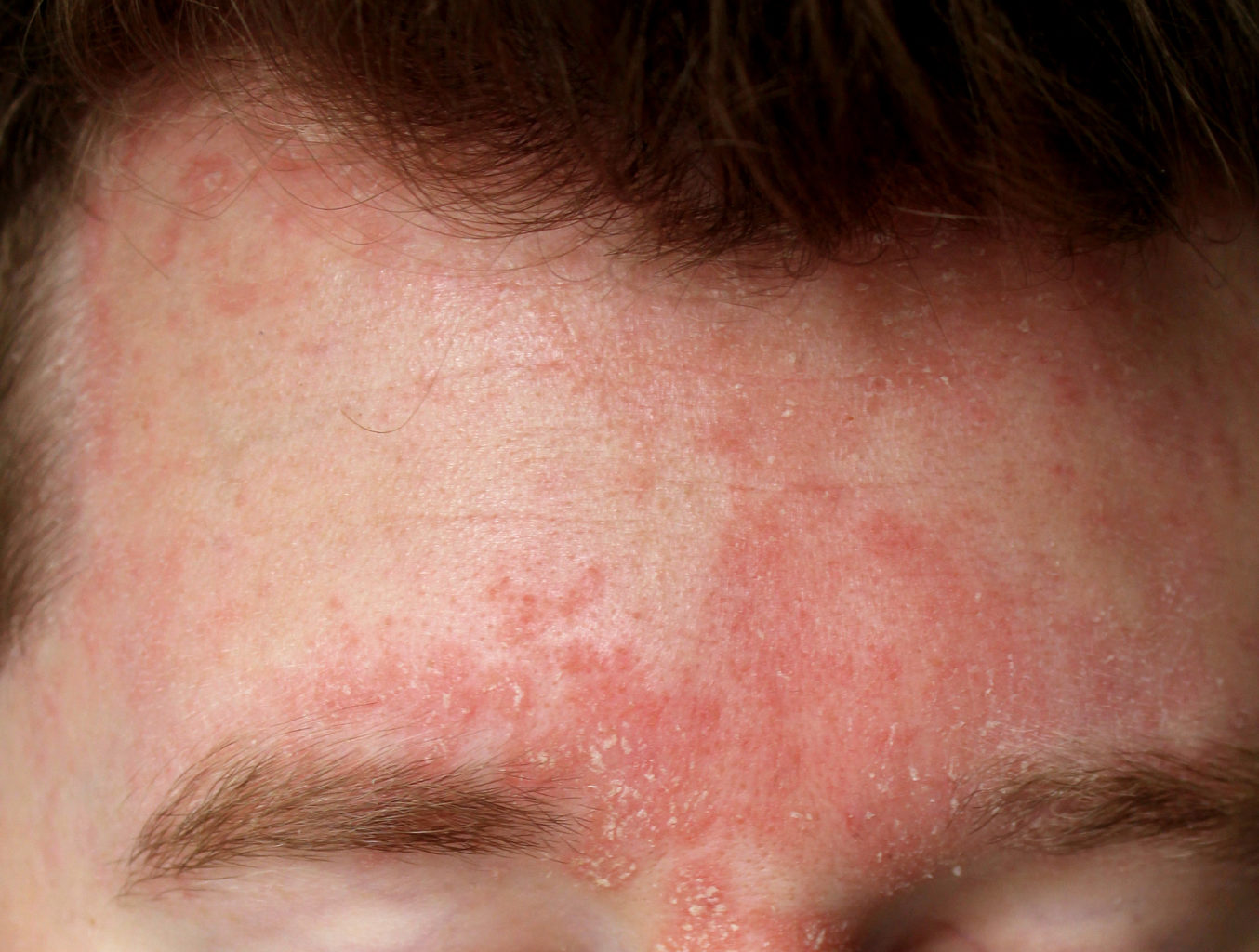What are the symptoms of seborrheic dermatitis?
Seborrheic dermatitis is a common skin condition characterized by inflammation of the sebaceous (oil) glands. The symptoms of seborrheic dermatitis can vary in severity and may include:
- Red, Flaky Skin: Areas affected by seborrheic dermatitis often have red, inflamed skin with flaky, dry patches. The flakes can be white or yellowish in color.
- Itching or Burning: The affected areas may be itchy or have a burning sensation. This can be uncomfortable and irritating.
- Greasy or Oily Skin: The skin in affected areas may appear greasy or oily due to the overproduction of sebum.
- Dandruff: When seborrheic dermatitis affects the scalp, it can cause dandruff, which is characterized by white or yellow flakes that shed from the scalp.
- Crusting: In more severe cases, the skin may develop crusty or scaly patches, particularly in areas where the skin folds or where sebaceous glands are prominent.
- Rashes: The condition commonly affects areas with high sebaceous gland activity, such as the scalp, face (particularly around the nose, eyebrows, and ears), and upper back. Rashes can appear as red, inflamed patches with visible flakes or scales.
- Dry, Oily, or Scaly Patches: Seborrheic dermatitis can cause patches of skin that are dry, scaly, or oily. These patches are often noticeable on the scalp, face, chest, or other areas of the body.
Symptoms of seborrheic dermatitis can be chronic and may flare up periodically. Treatment can help manage symptoms and reduce inflammation, but the condition may require ongoing care to keep it under control. If you experience symptoms of seborrheic dermatitis, consulting a dermatologist can help determine the best course of treatment.
What are the causes of seborrheic dermatitis?
Seborrheic dermatitis is a multifactorial condition with several potential causes and contributing factors:
- Overproduction of Sebum: One of the primary factors is an overproduction of sebum (skin oil) by the sebaceous glands. This excess oil can create an environment conducive to inflammation and irritation.
- Malassezia Yeast: The Malassezia yeast, a type of fungus that naturally resides on the skin, is often implicated in seborrheic dermatitis. An overgrowth of this yeast can lead to inflammation and exacerbate the condition.
- Genetics: Genetic predisposition may play a role in developing seborrheic dermatitis. Individuals with a family history of the condition may be more likely to experience it themselves.
- Hormonal Changes: Hormonal fluctuations, particularly those affecting androgens, can influence sebaceous gland activity and contribute to the development of seborrheic dermatitis.
- Immune System Factors: An abnormal immune response or immune system dysfunction can contribute to the development of seborrheic dermatitis. The condition may be associated with inflammatory responses to the Malassezia yeast.
- Environmental Factors: Environmental factors such as exposure to harsh weather conditions, extreme temperatures, and high humidity can aggravate seborrheic dermatitis.
- Stress: Emotional or physical stress can trigger or exacerbate symptoms of seborrheic dermatitis. Stress can impact the immune system and contribute to inflammation.
- Skin Conditions: Certain skin conditions, such as psoriasis or rosacea, can coexist with or contribute to seborrheic dermatitis.
- Medical Conditions: Underlying medical conditions, such as Parkinson’s disease, HIV/AIDS, or other chronic illnesses, can be associated with an increased risk of seborrheic dermatitis.
While the exact cause of seborrheic dermatitis can vary from person to person, managing these contributing factors can help control and alleviate symptoms. If you have concerns about seborrheic dermatitis, consulting a dermatologist can help determine the appropriate treatment and management strategies.
What is the treatment for seborrheic dermatitis?
Treatment for seborrheic dermatitis aims to manage symptoms, reduce inflammation, and control the overproduction of sebum. Common treatment options include:
- Medicated Shampoos: For scalp involvement, shampoos containing antifungal agents like ketoconazole or selenium sulfide, as well as tar-based shampoos, can help reduce yeast growth and inflammation.
- Topical Antifungals: Creams or lotions with antifungal agents such as ketoconazole, ciclopirox, or clotrimazole can help control the Malassezia yeast responsible for exacerbating the condition.
- Topical Corticosteroids: Mild to moderate corticosteroid creams or lotions can help reduce inflammation and itching. These are often used for short-term flare-ups or when the condition is particularly severe.
- Topical Calcineurin Inhibitors: Medications like tacrolimus or pimecrolimus may be prescribed as alternatives to corticosteroids, especially for sensitive areas like the face and eyelids.
- Emollients and Moisturizers: Regular use of moisturizers can help soothe dry, flaky skin and reduce irritation. Products that are non-comedogenic and free of fragrances or harsh chemicals are typically recommended.
- Tar-Based Products: Coal tar or other tar-based treatments can be used to reduce scaling and inflammation. These are usually applied topically.
- Salicylic Acid: Products containing salicylic acid can help reduce scaling and loosen flakes. They are often used in conjunction with other treatments.
- Lifestyle and Home Care: Managing stress, avoiding harsh skin care products, and using mild, non-irritating cleansers can help reduce flare-ups. Maintaining a consistent skincare routine and avoiding known irritants are also beneficial.
- Light Therapy: In some cases, phototherapy (light therapy) may be used to reduce inflammation and improve skin condition, particularly for severe or resistant cases.
- Oral Medications: For severe or widespread cases that do not respond to topical treatments, oral antifungal or systemic medications might be prescribed.
It’s important to consult with a dermatologist to determine the most appropriate treatment based on the severity and location of seborrheic dermatitis. Treatment plans can be adjusted based on individual response and any potential side effects.

Leave a Reply
You must be logged in to post a comment.